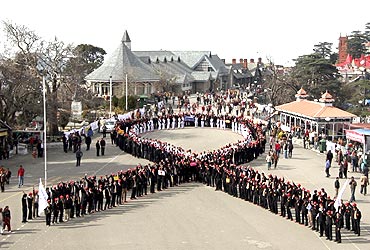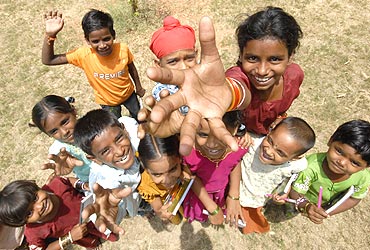Photographs: Anil Dayal/Reuters
Highlighting India's progress in HIV prevention efforts, a United Nations report has said that Indians rank AIDS high on their priority list of the most important issues facing the world.
"In India, nearly two thirds believe that the AIDS epidemic is more important than other issues the world is currently facing," said the report, which was launched in Geneva on Tuesday.
The report is based on an international public poll by the UN agency on AIDS, which surveyed adults in 25 countries representing all regions with nearly 12,000 respondents. The poll found that nearly 30 years into the AIDS epidemic, countries in every region continue to rank AIDS high on their priority list.
"Overall, respondents put AIDS as the top health-care issue in the world," the report said. "Furthermore, about half of the respondents are optimistic that the spread of HIV can be stopped by 2015."India has second highest number of HIV-positive people
Image: Children suffering from HIV/AIDS in HyderabadPhotographs: Krishnendu Halder/Reuters
At the same time, only one in three people believe the world is responding effectively to AIDS, and nearly six in ten believe it is the duty of the state to provide for free or subsidised treatment for people living with HIV.
The report noted that India had a much lower HIV prevalence -- less than 1 per cent -- but with a billion-strong population has the second highest number of HIV-positive people in the world.
The UN also cited the claim by the Indian government that near universal coverage of HIV prevention services has been achieved for men who have sex with men. The report highlighted the example of sex workers in Kolkata who are running cooperatives, managing health clinics and ensuring that underage girls do not enter the sex trade.
"They have also managed to keep HIV prevalence among sex workers low for the past two decades and are sharing their knowledge across the region," it said.
The UN noted that India was boosting HIV prevention efforts, with 67 per cent of the country's national AIDS budget earmarked for prevention. Over 245 million condoms, for instance, have already been distributed.
3,15,000 Indians receiving free treatment
Image: The Red Ribbon Express train at Jammu railway stationPhotographs: Amit Gupta/Reuters
The report cites K Chandramouli, chief of the National AIDS Control Organisation, as stating that the most important prevention strategy in India is to provide a package of prevention services for groups at higher risk of HIV infection.
As of March 2010, the number of such programmes had increased to 1,311, covering 78 per cent of female sex workers, 76 per cent of injecting drug users and 70 per cent of the men who have sex with men and trans-gender populations.
India's antiretroviral therapy programme has been increased to 270 centres. As of March 2010, more than 3,15,000 people were receiving free first-line treatment and more than 1,100 were accessing second-line drug regimens, according to Chandramouli.
The study also noted that large emerging economies, such as those of China, India and South Africa, had the ability to invest more in HIV prevention and treatment. It pointed out that China and India currently receive over $245 million each year as official development assistance for HIV that accounts for 8 per cent of the funds dispensed by the Global Fund to Fight AIDS, Tuberculosis and Malaria.
Red Ribbon halts at 180 stations
Image: A HIV-positive woman holds a placard during an awareness rallyPhotographs: Rupak De Chowdhuri/Reuters
"India has increased its health budget in recent years, riding on consistent economic growth," the report said. "However, it still accesses international assistance for a significant part of its AIDS response."
The UN asserted that countries such as Brazil, China, India, Mexico, the Russian Federation, Ukraine and Vietnam can fully finance their AIDS responses from domestic sources.
The UN report also pointed out that India's Red Ribbon, launched in 2007, is the region's largest mass mobilisation effort against HIV. The train stops at 180 stations across the country each year and is expected to reach 6.2 million people in more than 50,000 villages with critical information on HIV prevention.
The study by the world body further elaborated that the initiative included HIV testing and general health check-ups provided to the villagers.
"Six performing teams disembark the train on a fleet of bicycles to visit dozens of villages during each station stop, staging plays and skits about preventing HIV infection and fighting HIV-related stigma and discrimination," it said.





article